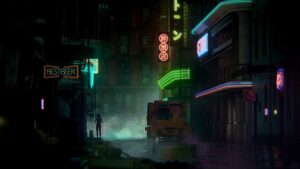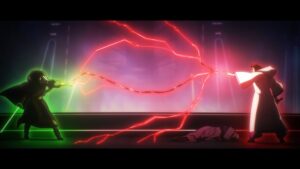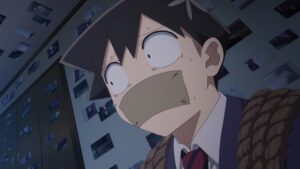Blade Runner: Black Lotus – 1-2
Wooper: Black Lotus is yet another of Sola Digital Arts’ CG reimaginings of classic sci-fi properties. Kenji Kamiyama (who also directed the Star Wars: Visions episode discussed below) and Shinji Aramaki have been pumping these out for a few years, and now it’s Blade Runner’s turn to get the Barbie treatment. So what’s the verdict, setting aside my distaste for the primitive 3D art style? After two episodes, I’d call it a passable replication; the rainy neon streets, murky lighting, and Vangelis-inspired soundtrack evoke the original film, but only superficially. (I haven’t seen 2049, so it may be that Black Lotus’s vacant streets are a more accurate reflection of Villeneuve’s sequel, but they certainly can’t hold a candle to the bustling exteriors of Ridley Scott’s version.) The story is a wisp of a thing with an amnesiac protagonist (Elle) and a handful of fight scenes to mask the absence of atmosphere. Most of the characters lean too far in one direction or another – the friendly black market trader is too helpful, while the corrupt senator is too evil. Episode 2’s final moments served as a pretty good hook, though – the show skillfully cut between Elle being hunted in both the past and the present, leading to a cliffhanger that honestly surprised me. I wouldn’t recommend this series to many people, but Blade Runner superfans can rest easy knowing it’s got a shade of promise.
Star Wars: Visions – 5
Wooper: “The Ninth Jedi” has the longest runtime of the Visions episodes I’ve seen so far (the longest of all nine, if Google is to be believed), but I felt as though my time with it passed the fastest. There was a crackerjack flow to the story here that I can’t quite dissect. My best guess would be the contrast between the stasis of the A part (a temple where a gathering of Jedi await their would-be leader) and the fluctuation of the B part (the daughter of a sabersmith flees her pursuers), which created a balance that effortlessly carried me along. The climactic lightsaber fight that resulted from the intersection of the two parts was highly satisfying, traditionally drawn as it was, but even before that, daughter Kara’s adaptability with regard to vehicles and locations (the showdown on the frozen lake!) made her a star. The fateful goodbye with her dad was obviously telegraphed, but all her other scenes were favorites of mine, especially the moment when her translucent lightsaber turned green as she threw herself headlong into combat at the temple. The best and worst aspect of “The Ninth Jedi” has to be its open-endedness – it’s awesome that it feels like a plausible launching pad for a much larger story, but at the same time, that story is unlikely to emerge in the future (though director Kamiyama has made his interest public). This is the high point of the anthology for me so far – we’ll see if any of the four remaining episodes can best it.
Komi-san wa, Komyushou desu – 4
Wooper: I’m three weeks behind at this point, so we’re slumming it with official subs from this point forward. This episode told a single story about a highly exaggerated character (not my favorite format), yet it still held my interest the whole time, so how bad can the Netflix script be? The exaggerated subject in question was Yamai Ren, whose name can be read as a pun on the word “yandere” – one of the thousands of bits of anime wordplay that have been lost on me over the years due to my EOP status. Naming a character after a trope or personality trait does signal a certain level of authorial awareness, but can it make the character any more interesting or likeable? I’d submit Ren as evidence that no, it can’t, but that’s okay because her freakish obsession with Komi presented the latter girl with an opportunity to grow. People who are intensely shy or reserved will sometimes look for opportunities to deny themselves the things they want, which is precisely what Komi did after Ren kidnapped Tadano: asked to dissolve her friendship with him. Thanks to Tadano’s encouragement and her own miniscule interpersonal progress, though, she threw out her request before the episode’s end, which I thought was great. Some people prefer not to watch shows like Komi-san because of their crazy presentation, but since this one is so good at heart, I can deal with a little craziness each week.







Yeah, these early manga chapters that Komi is adapting really suck the big one to be honest. It certainly gets much better once the author becomes accustomed to what he’s writing and the characterization improves greatly, but for now, it’s going to be slightly discomforting for some before it gets to the parts that people like.
And Wooper, you planning to look at Super Crooks this week? The comic itself is only 4 issues long, so much of the series is a prequel to the comic which takes place in the last third of this adaptation.
As for what I’m watching, Visual Prison certainly is this year’s Hypnosis Mic for sure. Only weirder and edgier since this is about visual kei vampires competing in literal “battle of the bands”. And a surprise gay confirmation (SagaMist) last week too between two members of one of the bands (expressed through a song performance of course but also through a flashback). Frankly, the show is lacking in narrative, much like HypMic’s boring episodic stories buoyed by the rap songs last year, but it’s still one hell of a guilty pleasure for me like this spring’s Fairy Ranmaru.
Meanwhile, PuraOre from its incredibly ugly hockey match two weeks ago and its desperate fan service episode last week effectively consigned itself into being the first in what will be a mass grave of failed franchise starters; attempts to cash in on the inexplicable success of Uma Musume. Dropped following the premiere but merely peeked back just to see how they actually will do a hockey game. I’d rather pretend that I saw that.
Apart from that, it’s just Ousama Ranking and Heike for me this season.
Sorry for the non-anime tangent, but Philip K Dick’s Do Androids Dream of Electric Sheep is a fantastic book.
Blade Runner 2049 is actually closer to Dick’s novel, in which Earth has been poisoned and depopulated after a nuclear war. On the other hand, 2049 has plot holes big enough to drive a Mack truck through, but it’s a beautifully shot picture with many wonderful cinematic moments. It also has a sequence where scrapyard bandits get at the MC by taking a ripsaw to the door of his flying car, then 5 minutes later he’s slamming it shut and jetting off… (that’s just lazy writing, not a plot hole).
But to the point, Blade Runner 2049 is not a true sequel to Ridley Scott’s film. Rather, Villenueve invents his own framework and drapes Scott’s Deckard and setting over it; in the same way, Scott’s Blade Runner is not an adaptation of Dick’s novel. Of the three, Philip K Dick tells the best story.
Anyone who’s only ever watched Scott’s or Villenueve’s films will probably be unpleasantly surprised to read Dick’s novel. Dick was a pulp fiction author through and through, recycling scenery and language, and not shying away from fantastical elements in his stories. Do Androids Dream of Electric Sheep is among the pulpiest of pulp science fiction.
But just as Banksy is a true artist who chooses graffiti as his medium, Dick was a true artist who was paid by the word. In fact, he may be the greatest science fiction writer America has ever produced. Travel long enough with his urbanite characters, trading witty jibes and biting ripostes as they zoom along in their rocketships or cross dark thresholds between one world and the next, and you will discover a truly inquisitive mind. Anti-authoritarian, anti-corporatist, anti-establishment, philosophical, and even more than a little mystical, Dick sends his characters on odysseys which often question reality itself.
I would have liked to have shook his hand. Did you know what the black iron prison would do to your work, Philip? For example, how it would turn Man in the High Castle on its head? But I read, and I understood. Others will too.